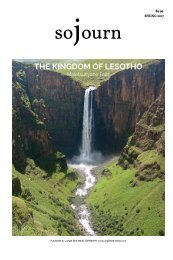Wrist Taker Magazine 2017 Issue
The 2017 issue of Wrist Taker lets you explore timepieces from lesser-known brands to luxury watches. Dive into the minds of independent watchmakers and find out what makes them tick. Or take a journey through 100 years of Baselworld and find out where, when and how it all began. Most important of all, feed your curiosity about timepieces whatever they may be!
The 2017 issue of Wrist Taker lets you explore timepieces from lesser-known brands to luxury watches. Dive into the minds of independent watchmakers and find out what makes them tick. Or take a journey through 100 years of Baselworld and find out where, when and how it all began. Most important of all, feed your curiosity about timepieces whatever they may be!
Create successful ePaper yourself
Turn your PDF publications into a flip-book with our unique Google optimized e-Paper software.
AAAAAAAAAAAAAAAAAAAAAAAA<br />
10<br />
A JOURNEY THROUGH<br />
TIME: 100 YEARS OF<br />
BASELWORLD<br />
Stadtcasino Basel, the first Swiss design fair in Basel, 1917<br />
The most important event in the horological<br />
calendar, Baselworld <strong>2017</strong> was the most<br />
exciting event as it happened one hundred<br />
years from the first ever Baselworld.<br />
There is no doubt that the previous 99<br />
Baselworld events have brought about some<br />
incredible moments. So we decided to look<br />
back at the history of Baselworld and how it<br />
became what it is known today.<br />
It all began a hundred years ago. The first<br />
Muba opened its doors in Basel. It was set up<br />
as a Sample Fair to support Swiss industry at<br />
the time of the First World War. Of the 831<br />
exhibiting companies, 29 belonged to the<br />
"Watches & Jewellery" group – a rather small<br />
sector for such a powerful industry. A few<br />
years before that, in 1912, the Swiss watch<br />
industry, with a market share of nearly 90 per<br />
cent, had more or less completely dominated<br />
the world market.<br />
At Muba it exhibited pocket watches, small<br />
wristwatches, wall clocks and chronometers.<br />
The principal items presented by the jewellery<br />
sector, on the other hand, were gold bracelets<br />
and rings, plus fashionable jewellery made of<br />
enamel and precious stones. The exhibitors<br />
also demonstrated the craftsmanship involved.<br />
The first Muba was a success. More than 300<br />
000 visitors streamed into the halls, and the<br />
companies concluded business worth more<br />
than 20 million Swiss francs<br />
Over the next few years the event started to<br />
attract more and more manufacturers from the<br />
watch industry. The first halls dedicated to the<br />
watch and jewellery centre were opened in<br />
1926 in the space where Hall 1 stands today.<br />
The growing influence of the watch industry<br />
led to the watch event being held in its own<br />
dedicated pavilion under the name of the<br />
“Swiss Watch Fair” in 1931. In many ways 1931<br />
was the start of the history of Baselworld in<br />
the form that it takes today. A year after that,<br />
the fair management officially declared the<br />
watch sector to be an autonomous specialist<br />
fair.<br />
The biggest names in the watch industry<br />
started to descend upon Baselworld in the<br />
coming years. Patek Philippe made their first<br />
appearance at Baselworld in 1932 and they<br />
have become one of the main attractions at the<br />
event over the years. Heuer (TAG Heuer today)<br />
appeared for the first time in 1934.<br />
WRIST TAKER 17







